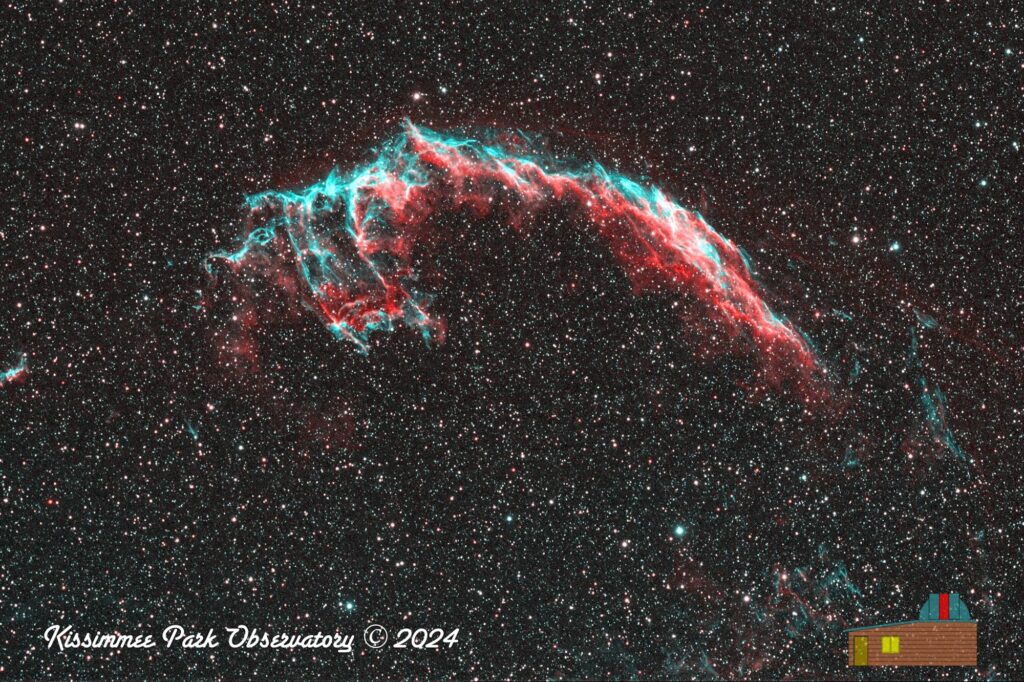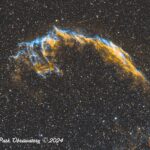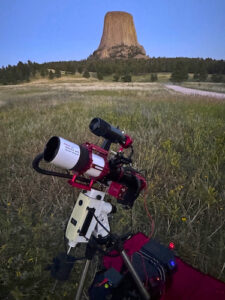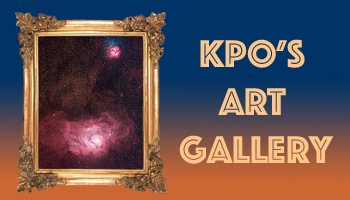
The Eastern Veil Nebula (NGC 6995), as captured by the WFAC at Devil’s Tower, Wyoming. HOO image, with a total integration time of 3 hours.
Unveiling the Mysteries of the Eastern Veil Nebula: NGC 6995
The Eastern Veil Nebula, formally known as NGC 6995, is a breathtaking cosmic wonder that has captivated astronomers and astrophotographers alike. Located approximately 2,400 light-years away in the constellation Cygnus, this diffuse nebula stands out amongst its celestial companions due to its ethereal beauty and intricate structure.
Discovery and Exploration
NGC 6995 was first recorded by William Herschel on September 16, 1784, who noted it as a faint, hazy patch of light. Over the years, astronomers have continued to study this nebula, unraveling its mysteries and revealing its stunning features.
The Nebula’s Structure
The Eastern Veil Nebula is part of a larger, more well-known astronomical object known as the Cygnus Loop or the Veil Supernova Remnant. This loop is a vast, star-forming region that spans hundreds of light-years in diameter. NGC 6995 itself appears as an elongated, rectangular patch of glowing gas, measuring roughly 3 degrees by 1 degree across.
The nebula’s coloration ranges from deep blue to pink and purple hues, depending on the concentration of ionized gases such as hydrogen, oxygen, and sulfur. These elements emit light when excited by high-energy radiation from nearby stars, particularly the bright, hot O-type stars in the Cygnus OB2 association.
The Role of Stars
Stars play a pivotal role in shaping the Eastern Veil Nebula’s structure. The intense radiation and strong stellar winds emanating from these celestial bodies ionize the surrounding gases, causing them to emit light across various wavelengths. As these gases cool down, they release their captured energy as visible light, painting the nebula with vibrant colors.
Astrophotography
Capturing the beauty of NGC 6995 is no easy task, as it requires specialized equipment and techniques. Astrophotographers often use narrowband filters to isolate specific wavelengths of light, allowing them to reveal the delicate details within this celestial tapestry. For example, this image was shot with Hydrogen Alpha and Oxygen III narrowband filters, then combined using the Ha as Red, and Oiii as Green and Blue. This is known as a “HOO” image structure, and results in a bicolor image that shows the dispersal of these two elemental gasses throughout the nebula. The color can be balanced differently as below but you still get an image that highlights the Hydrogen and Oxygen gasses.
(tap to see a full size image)
Conclusion
The Eastern Veil Nebula (NGC 6995) is a stunning example of the vast and complex beauty that lies within our cosmos. Its intricate structure, vibrant colors, and mysterious allure have captivated astronomers and astrophotographers alike for centuries. As we continue to explore this celestial wonder, we are reminded of the incredible mysteries still waiting to be uncovered in the vast expanse of space.
Tap on the image to view a lager version you can explore.
Image Info
This image was shot with the Wide Field Astrographic Camera (WFAC) during a night under the Bortle 2 skies of Devil’s Tower, WY.
- Imaged from Devil’s Tower, Wyoming (Bortle 2)
- Camera : ZWO ASI1600MM Pro
- Scope: Askar 400 Quintuplet Astrograph f/5.6
- Mount: iOptron Smart-EQ Pro
- Hydrogen Alpha: 18 subframes of 300s = 90 min integration
- Oxygen III: 18 subframes of 300s = 909 min integration
- Total integration time: 180 min = 3 hours.
- Captured via ASIAir Pro automation
- Optical tracking via ASIAir automation via the ASI174mm Pro guide camera
- Separate channels stacked and HOO integrated in Astro Pixel Processor
- Image run through Super DeNoising
- Final processing in Aperture
Buy this image as a print or framed art piece in our Art Gallery.



